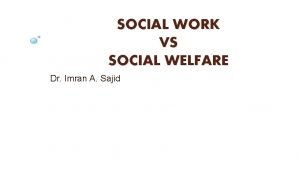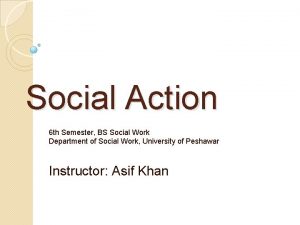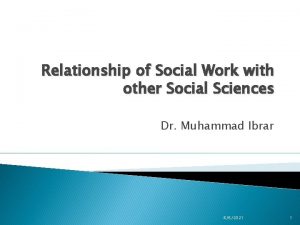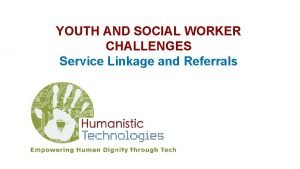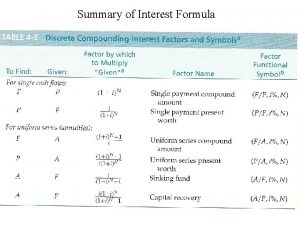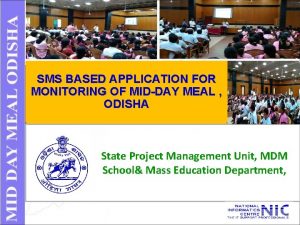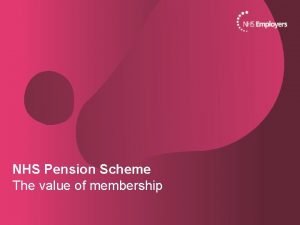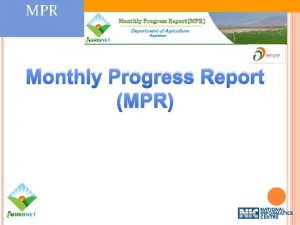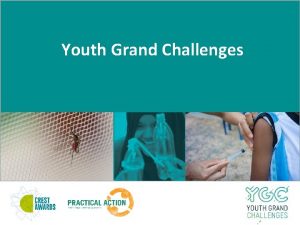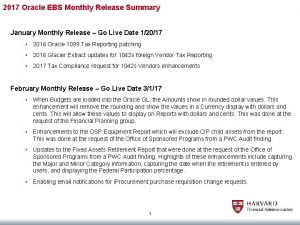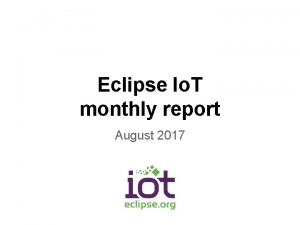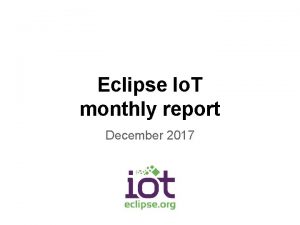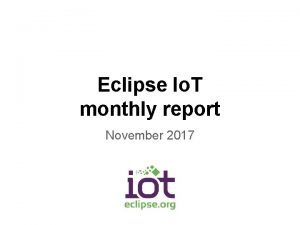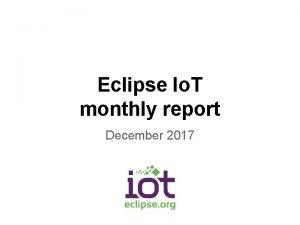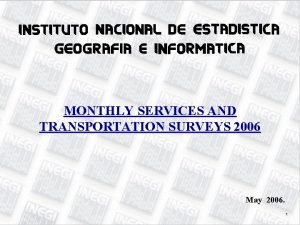WELCOME TO THE SOCIAL WORK GRAND CHALLENGES MONTHLY













































































- Slides: 77

WELCOME TO THE SOCIAL WORK GRAND CHALLENGES MONTHLY WEBINAR #1 OCTOBER 13, 2016 Today’s Webinar Topic Ensuring the healthy development of all youth by unleashing the power of prevention

For more information on the grand challenges monthly webinar series, please contact Sarah Butts: SBUTTS@SSW. UMARYLAND. EDU

Ensure healthy development for all youth Create social responses to a changing environment Close the health gap Harness technology for social good Stop family violence Promote smart decarceration Advance long and productive lives Reduce extreme economic inequality Eradicate social isolation Build financial capability for all End homelessness Achieve equal opportunity and justice


WEBINAR OBJECTIVES 1. Illustrate how Unleashing the Power of Prevention addresses the five criteria of the Social Work Grand Challenges (*Grand & Compelling *Scientifically informed *Achievable Impact w/in a Decade *Innovative *Collaborative) 2. Present Coalition for Behavioral Health’s action plan & Encourage other GC networks to develop an action plans 3. Illustrate progress on Unleashing the Power of Prevention action plan 4. Share key elements of action plan to achieve grand challenge goals as an example of ways to move Grand Challenges forward

WEBINAR SCHEDULE: (1½ HOURS) • Introduction - Dean Eddie Uehara 5 min • Building on the Advances of Prevention Science – Dr. Gil Botvin 10 min. • The 7 Action Steps to Unleash the Power of Prevention- Dr Jeff Jenson 15 min • Progress to Date – Dr. J. David Hawkins- 10 min • Preparing the Workforce for Roles in Prevention – Dr. Valerie Shapiro. 10 min • Key Elements in the Coalition’s Strategy – Dr. Jeff Jenson 10 minutes. • Dialog with Participants – All, 30 minutes

Advances in Prevention Science: From “Nothing Works” to Effective Approaches Gilbert J. Botvin, Ph. D. Weill Cornell Medical College National Health Promotion Associates Coalition for the Promotion of Behavioral Health October 2016

Why Focus on Behavioral Health Shift in causes of mortality From infectious to non-infectious disease Behavioral health problems Alcohol, drug abuse, prescription drug abuse Accidents, homicide, suicide Associated with chronic disease Heart disease, cancer, COPD, AIDS/HIV

Early Prevention Efforts: Drug Abuse Prevention Knowledge and Attitude Change Ineffective: No Decrease in Drug Use Some Drug Information Programs Increased Drug Use (Tobler, 1986) Lesson: Untested good ideas can sometimes make things worse. 9

Paradigm Shift: Toward a Public Health, Risk-Focused Approach to Prevention To Prevent a Problem Before It Happens Address its Predictors Research has Identified Risk Factors Protective Factors Develop Intervention to Target R/P Factors

Progress: 35 Years of Research RCTs: over 60 effective policies and programs Preventing behavioral health problems Substance abuse, delinquency and violence Mental health problems (depression, anxiety) Prevention Saves Money Sources Effective programs: www. blueprintsprograms. com Effective policies: Catalano et al. 2012, Hingson & White 2013, Vuolo et al. , 2015 • Cost Savings: www. wsipp. wa. gov/ • Lee, S. , Aos, S. , & Pennucci, A. (2015). What works and what does not? Benefit-cost findings from WSIPP. • •

Agency Recognition of Evidence-Based Programs

Effective Prevention Programs Good Behavior Game, Life Skills Training, Positive Action, Project Northland, Raising Healthy Children, Achievement Mentoring- Middle school, ATLAS, BASICS, Coping Power, Keep Safe, Familias Unidas, Strengthening Families 10 -14, Strong African-American Families, Guiding Good Choices, MST, Functional Family Therapy

Some EBPs Prevent Multiple Behavioral Health Problems Many Problems Share Risk Factors Addressing Shared Risk Factors Can Prevent Multiple Problems Some EBPs Prevent Multiple Problems Increasing Efficiency and Saving Money Three Examples: LST, NFP, SSDP

LST Program Elements Middle/JHS School Year 1: 15 sessions Year 2: 10 sessions Year 3: 5 sessions Interactive methods Provider Training Technical Assistance

Effectiveness 32 published studies Randomized Trials Short and long-term SA and violence Diverse populations Different providers Multiple replications $38 benefit: $1 cost

Nurse Family Partnership David Olds, Ph. D. Home visitors are trained public health nurses Guideline-driven and family-centered Visit from pregnancy through child age 2 Visit 2 -4 times a month: weekly during 1 st mo. , every other week through pregnancy, weekly for 1 st 6 weeks postpartum, & every other week until 2 nd birthday 100 family sites with specific staffing Caseload of 25 families per full-time nurse

Evidence of NFP Effects: Elmira Follow-Up Produced reductions of 40% - 60% in… Child abuse and neglect Arrest rate and convictions of the mothers (for poor, unmarried women only) Arrest rate of juveniles (for children of poor, unmarried women only) Problems associated with drug and alcohol abuse by mothers (poor, unmarried women only) 25% reduction in smoking during pregnancy (poor, unmarried) Benefit over cost: $3. 23 return on $1 invested (WSIPP, 2011).

Seattle Social Development Project Intervention Components Teacher Training in Classroom Instruction and Management • Opportunities, Recognition, Bonding, Positive Norms Parent Training in Behavior Management and Academic Support • Opportunities, Recognition, Bonding, Positive Norms Child Social, Emotional and Cognitive Skill Development • Skills, Self-Efficacy, Self Determination, Belief in Future

SSDP Changed Risk, Protection and Outcomes Intervention has specific benefits for children from th grade, those in the full By the start of 5 poverty through age 18. By age 18 Youths in the Full Hawkins et al. 1999, intervention had • More attachment to school Intervention had 2005; 2008; Lonczak et • less initiation of alcohol • Fewer held back in school al. , 2002. • less heavy alcohol use • less initiation of delinquency • Better achievement nd • less lifetime violence By age 21, broad significant effects were At the end of the 2 • better family management • Less school misbehavior By age 27, significant effects were found • less lifetime sexual activity found on positive adult functioning: grade • better family communication • • Less drinking and driving on educational and occupational outcomes, more high school graduates • fewer lifetime sex partners • boys less aggressive • better family involvemental health and risky sexual activity: • more attending college • improved school bonding • girls less self-destructive • higher attachment to family • more above median on SES attainment index • more employed • improved school achievement • fewer mental health disorders and symptoms • higher school rewards • better emotional and mental health • reduced school misbehavior • fewer lifetime sexually transmitted diseases • higher school bonding • fewer with a criminal record • less drug selling Late • less co-morbid diagnosis of substance abuse and mental health disorder Full Intervention Late Full Intervention Control Grade 1 2 3 4 5 6 7 8 9 10 11 12 Age 7 8 9 10 11 12 13 14 15 16 17 18 19 20 21 22 23 24 25 26 27

Power of Prevention within our Grasp • Implement Programs Proven to Work Leverage that Power • Combine EBPs Shown to Prevent Multiple Health Behavior Problems Develop an Action Plan to Unleash the Power of Prevention

WEBINAR SCHEDULE: (1½ HOURS) • Introduction - Dean Eddie Uehara 5 min • Building on the Advances of Prevention Science – Dr. Gil Botvin 10 min. • The 7 Action Steps to Unleash the Power of Prevention- Dr Jeff Jenson 15 min • Progress to Date – Dr. J. David Hawkins- 10 min • Preparing the Workforce for Roles in Prevention – Dr. Valerie Shapiro. 10 min • Key Elements in the Coalition’s Strategy – Dr. Jeff Jenson 10 minutes. • Dialog with Participants – All, 30 minutes

Ensure Healthy Development for all Youth by Unleashing the Power of Prevention Jeff Jenson, Ph. D. Philip D. and Eleanor G. Winn Endowed Professor for Children and Youth Graduate School of Social Work University of Denver Presentation for the Grand Challenges Webinar Series sponsored by the American Academy of Social Work and Social Welfare and the School of Social Work, University of Washington. October 13, 2016.

Background The Grand Challenge of Ensure healthy development for all youth includes two initiatives: Unleashing the Power of Prevention (Hawkins, Jenson, and Prevention of Schizophrenia and Severe Mental Illness the Coalition for the Promotion of Behavioral Health ) (De. Vylder) Co-Leads are Jeff Jenson, University of Denver and J. David Hawkins, University of Washington

Progress in Preventing Behavioral Health Problems! Anxiety Risky driving Selfinflicted injury Depression Aggressive behavior and conduct problems Risky sexual behavior Alcohol, tobacco, other drug use Delinquent behavior Violence School dropout

Despite this progress… Tested and effective interventions for preventing behavioral health problems are not widely used In fact. . . Prevention approaches that do not work or have not been evaluated are more widely used than those shown to be effective (Ringwalt, Vincus, et al. 2009)

Solution: Unleash the Power of Prevention… to ensure behavioral health of children through action grounded in research advances

What is Unleashing the Power of Prevention? A summary of evidence pertaining to behavioral health problems and an action plan aimed at increasing the use of preventive interventions Developed by the Coalition for the Promotion of Behavioral Health Published by the National Academy of Medicine Selected as a Grand Challenge initiative by the Academy of Social Work and Social Welfare in January, 2015

Goals of Unleashing the Power of Prevention Reduce the incidence and prevalence of behavioral health problems in the population of young people from birth through age 24 by 20% in a decade Reduce racial and socioeconomic disparities in behavioral health problems by 20% in a decade

Action Steps and Goals 1. Increase public awareness of the advances and cost savings of effective preventive interventions that promote healthy behaviors for all Goal: In a decade, a majority of the U. S. adult population will report that it is possible and cost-effective to prevent behavioral health problems among children and adolescents 2. Increase the percentage of all public funds that are spent on effective prevention programs Goal: In a decade, at least 10% of all state and federal expenditures on the education, health, protection, and welfare of children will be allocated to effective interventions for preventing behavioral health problems

Action Steps and Goals 3. Implement capacity-building tools that guide communities to assess and prioritize risk and protective factors, and select evidence-based prevention programs Goal 1: In a decade, at least 1, 000 communities in the United States will actively monitor population levels of risk and protection and behavioral health problems among young people Goal 2: In a decade, at least 1, 000 U. S. communities will implement effective health promotion approaches and evidencebased preventive interventions

Action Steps and Goals 4. Establish criteria for preventive interventions that are effective, sustainable, equity-enhancing, and cost-beneficial 5. Goal: In a decade, all 50 states will use data from controlled studies and cost-benefit analyses to inform policy decisions regarding investments in prevention, treatment, and control of behavioral health problems Increase infrastructure to support the high-quality implementation of preventive interventions Goal: In a decade, 25 states will have cross-agency “backbone” organizations that provide technical assistance and monitoring services to local community organizations that provide behavioral health services for youth and their families

Action Steps and Goals 6. Monitor and increase access of children, youth, and young adults to effective preventive interventions 7. Goal: In a decade, child welfare, education, health, justice, and other agencies in 20 states will use integrated data structures that enable cross-agency monitoring of behavioral health and preventive interventions Create workforce development strategies to prepare practitioners in health and human service professions for new roles in promotion and preventive interventions Goal: In a decade, 20 universities will include crossdisciplinary, prevention-focused training programs in behavioral health that will include primary care medicine, nursing, psychiatry, social work, and psychology

Measuring Progress Our goals are achievable Multisite trials of community-wide prevention systems using effective programs have produced reductions of 25 to 33 percent in delinquency and drug use (Hawkins et al. , 2012; Spoth et al. , 2011) Success will be measurable through state and national data systems that track trends in behavioral health problems State-sponsored surveys National surveys and databases: America’s Children: Key Indicators of Well-Being Centers for Disease Control: Youth Risk Behavioral Surveillance System Kids Count, Annie E. Casey Healthy People 2020 National Survey of Children’s Health Other

Summary The Grand Challenge of Ensure healthy development for all youth by Unleashing the power of prevention seeks to: Reduce a pressing social problem at the population level Use empirical evidence to bring efficacious and cost-effective preventive polices and interventions to scale Improve infrastructure for preventive interventions and policies across levels of government Reduce social, economic, and racial injustice Educate practitioners and policymakers in prevention Compliment other Grand Challenges of social work

Coalition for the Promotion of Behavioral Health Coalition Steering Committee: Jeff Jenson, Ph. D, Chair, University of Denver J. David Hawkins, Ph. D, University of Washington Richard F. Catalano, Ph. D, University of Washington Valerie Shapiro, Ph. D, University of California at Berkeley Kimberly Bender, Ph. D, University of Denver Mark Fraser, Ph. D, University of North Carolina-Chapel Hill Gilbert J. Botvin, Ph. D, Cornell University Brian Bumbarger, Ph. D, Pennsylvania State University For information, contact: Jeff Jenson, Ph. D at: Jeffrey. Jenson@du. edu

Unleashing the Power of Prevention is published as a Discussion Paper by the National Academy of Medicine. It is available at: http: //nam. edu/perspectives-2015 -unleashingthe-power-of-prevention/ Academy of Social Work and Social Welfare: http: //aaswsw. org/grand-challenges-initiative/

WEBINAR SCHEDULE: (1½ HOURS) • Introduction - Dean Eddie Uehara 5 min • Building on the Advances of Prevention Science – Dr. Gil Botvin 10 min. • The 7 Action Steps to Unleash the Power of Prevention- Dr Jeff Jenson 15 min • Progress to Date – Dr. J. David Hawkins- 10 min • Preparing the Workforce for Roles in Prevention – Dr. Valerie Shapiro. 10 min • Key Elements in the Coalition’s Strategy – Dr. Jeff Jenson 10 minutes. • Dialog with Participants – All, 30 minutes

ENSURE HEALTHY DEVELOPMENT FOR ALL YOUTH BY UNLEASHING THE POWER OF PREVENTION Initiatives and Progress J. David Hawkins, Ph. D Social Development Research Group School of Social Work University of Washington Grand Challenges for Social Work Webinar #1: October 13, 2016

COALITION FOR THE PROMOTION OF BEHAVIORAL HEALTH FOUR INITIATIVES 1. Publish and publicize a call to action to increase the use of effective preventive interventions for behavioral health problems. 2. Collaborate with states to improve community-level prevention capacity and state-level prevention backbone coordination and infrastructure. 3. Promote healthy parenting through primary care. 4. Work with universities, states, and communities to develop the prevention workforce - Valerie Shapiro and Kim Bender

1. UNLEASHING THE POWER OF PREVENTIONOUR CALL TO ACTION (HTTPS: //NAM. EDU/PERSPECTIVES-2015 -UNLEASHING-THE-POWER-OF-PREVENTION/) • We need interdisciplinary collaboration to succeed. • Therefore, we engaged diverse interdisciplinary authors.

AUTHORS J. David Hawkins, Ph. D Mary Jane Rotheram-Borus, Ph. D Jeffrey M. Jenson, Ph. D Pat Shea, MSW Richard Catalano, Ph. D Andy Shih, Ph. D Mark Fraser, Ph. D Elizabeth Anthony, Ph. D Gilbert J. Botvin, Ph. D Kevin P. Haggerty, Ph. D Valerie Shapiro, Ph. D Kimberly Bender, Ph. D C. Hendricks Brown, Ph. D Deborah Gorman-Smith, Ph. D William Beardslee, MD Erin Casey, Ph. D David Brent, MD Susan Stone, Ph. D Laurel K. Leslie, MD, MPH

1. UNLEASHING THE POWER OF PREVENTIONOUR CALL TO ACTION (HTTPS: //NAM. EDU/PERSPECTIVES-2015 -UNLEASHING-THE-POWER-OF-PREVENTION/) • We need interdisciplinary collaboration to succeed. • Therefore, engaged interdisciplinary authors. • Published first online as discussion paper by the National Academy of Medicine. • Committed to broad, strong and accurate scientific foundation. • Committed to specific attainable goals and actions with measurable indicators of progress. • The seven action steps guide initiatives of the Coalition for the Promotion of Behavioral Health. • Publicize the call to action in interdisciplinary settings.

1 - PUBLICIZING THE CALL TO ACTION: PRESENTATIONS J. David Hawkins. From Nothing Works to Unleashing the Power of Prevention. National Prevention Network Research Conference. Seattle, WA. November 17, 2015. J. David Hawkins. Ensuring Healthy Development for All Youth: Unleashing Universal, Selective, and Indicated Prevention, 2016 Society for Social Work Research Conference. Washington, DC. January 15, 2016. Richard F. Catalano. Ensuring Healthy Development for all Youth: Unleashing the Power of Prevention through Parenting in Primary and Tertiary Care. Annual Meeting of the Society for Adolescent Health and Medicine. March 9, 2016. J. David Hawkins. Unleashing the Power of Prevention. A Plan to Advance Effective Policy and Practice to Prevent Behavioral Health Problems. Board on Children, Youth and Families of the National Academies of Science, Engineering and Medicine. Washington, DC. March 9, 2016. Brian Bumbarger. Unleashing the Power of Prevention: Schools & Communities Partnering for Collective Impact. Utah State Office of Education Annual Student Services Director's Meeting. St. George, UT. March 2016. Jeffrey M. Jenson. Ensuring Healthy Development for all Youth: The Power of Prevention. Tate Lecture, School of Social Work, University of North Carolina, Chapel Hill, North Carolina. April 14, 2016. Richard F. Catalano. Reducing Health Disparities and Improving Equity through Prevention: An Example of the Power of Prevention. Society for Prevention Research Presidential Address. San Francisco, CA. June 1 2016. Richard F. Catalano. Unleashing the Power of Prevention. NASADAD/NPN Meeting. Salt Lake City, UT. June 8, 2016. Brian Bumbarger. Unleashing the Power of Prevention: Utah Communities Partnering for Collective Impact. Utah Prevention Coalition Association 3 rd Annual Utah Prevention Coalition Training Summit. Bryce Canyon, UT. June 2016. Richard F. Catalano. Using the Research Base for Prevention Science to Reduce Behavioral Health Problems: Communities That Care. Texas Behavioral Health. Austin, TX. July 12, 2016. Jeffrey M. Jenson. Promoting Positive Behavioral Health in Children and Youth: Unleashing the Power of Prevention. Annual Conference of the Georgia State Office of Behavioral Health Prevention. Atlanta, GA. August 2, 2016.

1 - PUBLICIZING THE CALL TO ACTION: PRESENTATIONS G. J. Botvin. Unleashing the Power of Prevention through Evidence-Based Programs: Programs versus Principles. The National Academy of Sciences. Washington, DC. June 9, 2016. Jeffrey M. Jenson. Preventing Behavioral Health Problems in Young People: A National Call to Action. Annual Meeting of the American Psychological Association. Denver, CO. August 5, 2016. Brian Bumbarger. Unleashing the Power of Prevention at Scale: Researchers, Communities & Public Systems Partnering for Collective Impact. 2016 APA Annual Convention. Denver, CO. August 2016. J. Brown, F. Harding, J. D Hawkins, G. J. Botvin, An Open Dialogue on Current and Emerging Issues in Substance Misuse Prevention Research. National Prevention Network, Annual Conference. Buffalo, NY. September 13, 2016. Jeffrey M. Jenson. Ensure Healthy Development for all Youth: Strategies, Progress, and Challenges. Grand Challenges Policy Conference. Washington University. St. Louis, MO. September 16, 2016. J. David Hawkins. From Nothing Works to Effective Prevention. Stopping DUIs Before They Start: Montana Interagency Coordinating Council for State Prevention Programs Community Engagement Conference. Anaconda, MT. September 20, 2016. Brian Bumbarger. Colorado Schools, Communities and Public Systems Working Together to Unleash the Power of Prevention. Colorado Department of Public Safety, School Safety Resource Center 2016 Colorado Safe Schools Summit. Denver, CO. October 2016. Richard F. Catalano. Unleashing the Power of Prevention. Conrad N. Hilton Foundation Annual Convening. Washington, DC. October 13, 2016. J. David Hawkins. Building Local Capacity to Prevent Prescription & Opiate Drug Abuse Before it Happens. 7 th Annual Prescription Drug Abuse & Heroin Symposium. Indianapolis, IN. October 14, 2016.

2 - STATE COLLABORATIONS: STRUCTURE AND PROGRESS Leadership of State project team: Jeffrey Jenson-lead, J. David Hawkins, Gil Botvin, Richard Catalano, Brian Bumbarger (link to National Prevention Science Coalition). • Utah Prevention Summit, December 4, 2015 Coalition’s state project team invited to Utah to speak to state policy makers, and state agency lead administrators on unleashing the power of prevention. • Utah Prevention Webinar, May 10, 2016 Coalition state team invited to present a webinar for staff of state agencies on unleashing the power of prevention. Sponsored by the Utah Division of Substance Abuse and Mental Health. • Working with the Colorado Results First initiative to create a statewide prevention coalition guided by the goals and strategies of Unleashing the Power of Prevention

3 - HEALTHY PARENTING IN PRIMARY CARE: GOALS • Ensure a strong research foundation for reimbursement/payment for tested, effective family focused prevention programs in primary care. • Develop models for practice integration to provide family focused preventive services in primary care practices or through billable community referral systems. • Increase public awareness of the effectiveness of family focused prevention of behavioral health problems and change public expectations, norms and support for participation. • Increase awareness, acceptance and support among health professionals, for family focused prevention in primary care. • Prepare a work force to effectively deliver proven family focused prevention programs in primary care settings at scale in the US.

3 - HEALTHY PARENTING IN PRIMARY CARE: STRUCTURE & PROCESS Structure: • Collaborative on Healthy Parenting in Primary Care, an initiative of the Forum on Promoting Children’s Cognitive, Affective, and Behavioral Health at the National Academies of Sciences, Engineering, and Medicine. • J. David Hawkins and Sarah Tracey- leads. Over 70 members- MD, Ph. D, Psy. D, MPH, RN, MSW, JD… Process: Quarterly collaborative conference calls –structured around goals, action, opportunities. • • • Research project links. (Goal 1) Op-eds, university alumni magazine articles, tweets, blogs etc. (Goal 3) Conference presentations. (Goal 4) • • • Congressional briefing (Goals 3 & 4) Policy and advocacy (Goals 1, 2, 3, 4) Learning collaborative (Goal 2) Work groups:

PROGRESS: COLLABORATIVE ON HEALTHY PARENTING IN PRIMARY CARE • Primary Health Care: Potential Home for Family-Focused Preventive Interventions. Laurel K. Leslie, et al. 2016. American Journal of Preventive Medicine. • Viewpoint: Parenting as Primary Prevention. Ellen C. Perrin, et al. 2015. JAMA Pediatrics • Congressional Briefing on Healthy Parenting in Primary Care Hosted by Sen. Lamar Alexander & Sen. Patty Murray. co-sponsored by National Prevention Science Coalition, AAP, ABP, AAFP, AASWSW, Coalition for Promotion of Behavioral Health & more - April, 2016. • Family Focused Prevention in Pediatric Primary Care Settings. Mary Ann Mc. Cabe et al. August 2016. Annual Convention, American Psychological Association • Working with AAP to ensure family-focused preventive interventions are included in Bright Futures guidelines. • Developing proposal for a learning collaborative on healthy parenting in primary care in collaboration with AAP & AAFP. • Meetings with congressional staffers and federal agency leaders to identify opportunities to advance healthy parenting in primary care. • Comments on USPSTF, CMS, CMMI reports and documents relevant to our goals.

PROGRESS: HEALTHY PARENTING IN PRIMARY CARE RESOURCES AVAILABLE TO COLLABORATIVE MEMBERS Thanks to Sarah Tracey and NASEM Collaborative Initiative Overview Collaborative Roster Congressional Briefing Video Storify Tweets from Congressional Briefing #Powerof. Parenting Materials from Congressional Briefing Perrin et al. 2015 JAMA Pediatrics Viewpoints commentary Michael Marmott article on parenting Recent NPR coverage of Rahil Brigg’s work Leslie et al. 2016 : Primary Health Care: Potential Home for Family-Focused Preventive Interventions Paul Tough’s piece on parenting in the NY Times

WEBINAR SCHEDULE: (1½ HOURS) • Introduction - Dean Eddie Uehara 5 min • Building on the Advances of Prevention Science – Dr. Gil Botvin 10 min. • The 7 Action Steps to Unleash the Power of Prevention- Dr Jeff Jenson 15 min • Progress to Date – Dr. J. David Hawkins- 10 min • Preparing the Workforce for Roles in Prevention – Dr. Valerie Shapiro. 10 min • Key Elements in the Coalition’s Strategy – Dr. Jeff Jenson 10 minutes. • Dialog with Participants – All, 30 minutes

Grand Challenges for Social Work initiative Unleashing the Power of Prevention: Train and enable a workforce for effective prevention practice Presented By: Valerie B. Shapiro School of Social Welfare University of California Berkeley Unleashing the Power of Prevention: Train and enable a workforce for effective prevention practice ● Grand Challenges initiative

Collaborators Kimberly A. Bender, University of Denver Co-Chair of Workforce Workgroup Additional Steering Committee Members Coalition for the Promotion of Behavioral Health J. David Hawkins, University of Washington Jeffrey M. Jenson, University of Denver Richard F. Catalano, University of Washington Gilbert J. Botvin, Cornell University Mark Fraser, University of North Carolina at Chapel Hill Brian Bumbarger, Pennsylvania State University Unleashing the Power of Prevention: Train and enable a workforce for effective prevention practice ● Grand Challenges initiative

Prevention Decade: Actionable Goals “Create workforce development strategies to prepare practitioners in health and human service professions for new roles in promotion and preventive interventions” Unleashing the Power of Prevention: Train and enable a workforce for effective prevention practice ● Grand Challenges initiative

Prevention Decade: Actionable Goals “Train and enable a workforce for effective prevention practice” Unleashing the Power of Prevention: Train and enable a workforce for effective prevention practice ● Grand Challenges initiative

Prevention Decade: Actionable Goals • Goal 1 - In a decade, 20 universities will include crossdisciplinary, prevention-focused training programs in behavioral health that will include primary care medicine, nursing, psychiatry, social work, and psychology. • Goal 2 - In a decade, 25 schools of social work or schools of public health will include an evidence-based behavioral health promotion and prevention curriculum track in their master’s programs. Unleashing the Power of Prevention: Train and enable a workforce for effective prevention practice ● Grand Challenges initiative

The “Why” • We need skilled prevention coordinators (e. g. , 40 in CO) – – – Community organizing and stakeholder engagement Systematic assessment community-wide Summarize data and develop action plans Leverage youth serving organizations for programming Manage implementation fidelity • We need skilled prevention workers – Read, comprehend, and critique the results of prevention trials – Deliver effective universal, selective, and indicated programs Unleashing the Power of Prevention: Train and enable a workforce for effective prevention practice ● Grand Challenges initiative

The “Who” • Rooted in the use of epidemiologic data to advocate for prevention and guide action • Aims to understand individual behavior in a social context; Includes individual & community levels of intervention • Trainees exposed to many types of organizations and agencies affecting children and families • Encourages active involvement of clients in solving problems while seeking to use evidencebased practices Unleashing the Power of Prevention: Train and enable a workforce for effective prevention practice ● Grand Challenges initiative

The “How” • Undergraduate Education à Consumers, community members, non-service sector professionals, paraprofessionals • Pre-Service Training for Prevention Skills à Bachelors, Masters, Doctoral • In-Service Training for Prevention Expertise à Certificates, Continuing education Unleashing the Power of Prevention: Train and enable a workforce for effective prevention practice ● Grand Challenges initiative

The “How” • The Behavioral Health Workforce Education and Training Program should continue funding instruction for all disciplines that provide prevention services. • State licensure boards must refine licensure standards or develop new licensing mechanisms that recognize professional practice and mastery in preventive interventions. • Develop adequate field education opportunities for learning effective prevention practice (e. g. , University of Washington “Communities In Action” program) Unleashing the Power of Prevention: Train and enable a workforce for effective prevention practice ● Grand Challenges initiative

Reference Hawkins, J. D. , Shapiro, V. B. , & Fagan, A. A. (2010). Moving toward effective community prevention practices: Opportunities for social work education. Research on Social Work Practice, 20(5), 518 -527. Unleashing the Power of Prevention: Train and enable a workforce for effective prevention practice ● Grand Challenges initiative

The Workgroup Valerie Shapiro & Kimberly Bender Co-Chairs of Workforce Workgroup Additional Workgroup Members Deborah Gorman-Smith, University of Chicago Kevin Haggerty, University of Washington Anne Williford, University of Kansas Elizabeth Anthony, Arizona State University Trish Kohl, Washington University Elizabeth Kim, University of Southern California Unleashing the Power of Prevention: Train and enable a workforce for effective prevention practice ● Grand Challenges initiative

The Current Work • Collaborate with CSWE (e. g. , “Grand Challenge Flag”) • Standardized Learning Objectives – Advanced Social Work Practice in the Prevention of Substance Use Disorders (2009) • List of Existing Prevention Programs – 21 Programs in Public Health Social Work • Repository of Existing Course Syllabi – School, Family, Community Prevention (Denver) • Systematic Study of Current Practices – Foundation Curriculum – Advanced (e. g. , SAMSHA Integrated Behavioral Healthcare) Unleashing the Power of Prevention: Train and enable a workforce for effective prevention practice ● Grand Challenges initiative

Grand Challenges for Social Work Initiative Presented By: Valerie B. Shapiro Unleashing the Power of Prevention: Train and enable a workforce for effective prevention practice http: //aaswsw. org/grand-challenges-initiative/12 -challenges/ensurehealthy-development-for-all-youth/ https: //nam. edu/wp-content/uploads/2015/06/DPPowerof. Prevention. pdf https: //csd. wustl. edu/Publications/Documents/PB 1. pdf Unleashing the Power of Prevention: Train and enable a workforce for effective prevention practice ● Grand Challenges initiative

WEBINAR SCHEDULE: (1½ HOURS) • Introduction - Dean Eddie Uehara 5 min • Building on the Advances of Prevention Science – Dr. Gil Botvin 10 min. • The 7 Action Steps to Unleash the Power of Prevention- Dr Jeff Jenson 15 min • Progress to Date – Dr. J. David Hawkins- 10 min • Preparing the Workforce for Roles in Prevention – Dr. Valerie Shapiro. 10 min • Key Elements in the Coalition’s Strategy – Dr. Jeff Jenson 10 minutes. • Dialog with Participants – All, 30 minutes

Ensure Healthy Development for all Youth by Unleashing the Power of Prevention: Strategies and Challenges Jeff Jenson, Ph. D. Philip D. and Eleanor G. Winn Endowed Professor for Children and Youth Graduate School of Social Work University of Denver Presentation for the Grand Challenges Webinar Series sponsored by the American Academy of Social Work and Social Welfare and the School of Social Work, University of Washington. October 13, 2016.

What are the strategies being used to advance the goals of Ensure Healthy Development for all Youth by Unleashing the Power of Prevention?

Action Steps and Goals 1. Increase awareness of preventive interventions 2. Increase funding for effective prevention programs 3. Implement capacity-building tools to guide the selection of effective programs 4. Establish criteria for preventive interventions 5. Increase backbone infrastructure for prevention 6. Monitor and increase access to preventive interventions 7. Develop a prevention workforce

Key Strategy Approaches: Ensure Healthy Development for all Youth Create a coalition of researchers, policymakers, and practitioners to support the Grand Challenge Provide opportunities for coalition members to contribute to a position paper that defines goals and actions necessary to achieve the Grand Challenge

Key Strategy Approaches: Ensure Healthy Development for all Youth Provide opportunities for people, groups, and organizations to endorse the position paper – build support! Some organizational partners: The Society for Child and Family Practice and Policy, American Psychological Association, Division 37. http: //www. apa. org/about/division/div 37. aspx National Association of State Mental Health Program Directors. http: //www. nasmhpd. or Mental Health America. http: //www. mentalhealthamerica. net National Prevention Science Coalition to Improve Lives. http: //www. npscoalition. org Department of Psychiatry and Behavioral Sciences. Division of Public Behavioral Health and Justice Policy. University of Washington. http: //depts. washington. edu/pbhjp/

Key Strategy Approaches: Ensure Healthy Development for all Youth Create a structure within the Coalition to support activities defined in the action plan Form a steering committee Create committees to organize, coordinate, and conduct the work of the Coalition Membership and Outreach; J. David Hawkins Workforce Development; Kim Bender & Valerie Shapiro Dissemination; Jeff Jenson Funding; Richard Catalano

Coalition for the Promotion of Behavioral Health Coalition Steering Committee: Jeff Jenson, Ph. D, Chair, University of Denver J. David Hawkins, Ph. D, University of Washington Richard F. Catalano, Ph. D, University of Washington Valerie Shapiro, Ph. D, University of California at Berkeley Kimberly Bender, Ph. D, University of Denver Mark Fraser, Ph. D, University of North Carolina-Chapel Hill Gilbert J. Botvin, Ph. D, Cornell University Brian Bumbarger, Ph. D, Pennsylvania State University

Key Strategy Approaches: Healthy Development for all Youth Give responsibilities to members Encourage leadership roles Develop and implement outreach strategies Hold special interest group meetings at SSWR, SPR, and other conferences Distribute E-newsletters that highlight progress Conduct webinars Create presentation and publication goals Share the position paper!!

Key Strategy Approaches: Healthy Development for all Youth Use related opportunities to expand the reach of the Grand Challenge: Presentations at policy, research, state, and national conferences Capitalize on work being conducted by Coalition members in other settings and organizations (e. g. , Society for Prevention Research, Institute of Medicine, National Prevention Science Coalition to Improve Lives, SSWR, CSWE, NASW)

Challenges Creating the infrastructure necessary to support tasks and meet goals Securing funding for infrastructure, coordination, communication, and other activities Involving Coalition members in new activities and leadership roles Rigorously measuring the effects of the Grand Challenge on stated goals Sustaining efforts in the next decade

Unleashing the Power of Prevention is published as a Discussion Paper by the National Academy of Medicine. It is available at: http: //nam. edu/perspectives-2015 -unleashingthe-power-of-prevention/ Academy of Social Work and Social Welfare: http: //aaswsw. org/grand-challenges-initiative/

Q&A
 Industrial strategy grand challenges
Industrial strategy grand challenges Objectives of group work
Objectives of group work What are the components of social work
What are the components of social work Social welfare vs social work
Social welfare vs social work Scope of social action
Scope of social action Relationship between political science and social work
Relationship between political science and social work Global agenda for social work and social development
Global agenda for social work and social development Social change in social work
Social change in social work Wise men three clever are we
Wise men three clever are we Social thinking adalah
Social thinking adalah Social thinking social influence social relations
Social thinking social influence social relations Social challenges
Social challenges Social challenges
Social challenges Grand exchange social
Grand exchange social Good morning welcome back
Good morning welcome back Good morning welcome back to work
Good morning welcome back to work Hát kết hợp bộ gõ cơ thể
Hát kết hợp bộ gõ cơ thể Frameset trong html5
Frameset trong html5 Bổ thể
Bổ thể Tỉ lệ cơ thể trẻ em
Tỉ lệ cơ thể trẻ em Voi kéo gỗ như thế nào
Voi kéo gỗ như thế nào Thang điểm glasgow
Thang điểm glasgow Hát lên người ơi
Hát lên người ơi Các môn thể thao bắt đầu bằng tiếng chạy
Các môn thể thao bắt đầu bằng tiếng chạy Thế nào là hệ số cao nhất
Thế nào là hệ số cao nhất Các châu lục và đại dương trên thế giới
Các châu lục và đại dương trên thế giới Công thức tính độ biến thiên đông lượng
Công thức tính độ biến thiên đông lượng Trời xanh đây là của chúng ta thể thơ
Trời xanh đây là của chúng ta thể thơ Mật thư tọa độ 5x5
Mật thư tọa độ 5x5 101012 bằng
101012 bằng Phản ứng thế ankan
Phản ứng thế ankan Các châu lục và đại dương trên thế giới
Các châu lục và đại dương trên thế giới Thơ thất ngôn tứ tuyệt đường luật
Thơ thất ngôn tứ tuyệt đường luật Quá trình desamine hóa có thể tạo ra
Quá trình desamine hóa có thể tạo ra Một số thể thơ truyền thống
Một số thể thơ truyền thống Cái miệng bé xinh thế chỉ nói điều hay thôi
Cái miệng bé xinh thế chỉ nói điều hay thôi Vẽ hình chiếu vuông góc của vật thể sau
Vẽ hình chiếu vuông góc của vật thể sau Biện pháp chống mỏi cơ
Biện pháp chống mỏi cơ đặc điểm cơ thể của người tối cổ
đặc điểm cơ thể của người tối cổ Giọng cùng tên là
Giọng cùng tên là Vẽ hình chiếu đứng bằng cạnh của vật thể
Vẽ hình chiếu đứng bằng cạnh của vật thể Phối cảnh
Phối cảnh Thẻ vin
Thẻ vin đại từ thay thế
đại từ thay thế điện thế nghỉ
điện thế nghỉ Tư thế ngồi viết
Tư thế ngồi viết Diễn thế sinh thái là
Diễn thế sinh thái là Dạng đột biến một nhiễm là
Dạng đột biến một nhiễm là Số nguyên tố là
Số nguyên tố là Tư thế ngồi viết
Tư thế ngồi viết Lời thề hippocrates
Lời thề hippocrates Thiếu nhi thế giới liên hoan
Thiếu nhi thế giới liên hoan ưu thế lai là gì
ưu thế lai là gì Sự nuôi và dạy con của hổ
Sự nuôi và dạy con của hổ Khi nào hổ mẹ dạy hổ con săn mồi
Khi nào hổ mẹ dạy hổ con săn mồi Sơ đồ cơ thể người
Sơ đồ cơ thể người Từ ngữ thể hiện lòng nhân hậu
Từ ngữ thể hiện lòng nhân hậu Thế nào là mạng điện lắp đặt kiểu nổi
Thế nào là mạng điện lắp đặt kiểu nổi Monthly expansion factor formula
Monthly expansion factor formula Housekeeping monthly the good wife's guide
Housekeeping monthly the good wife's guide Housekeeping monthly, 1955
Housekeeping monthly, 1955 What is discrete compounding
What is discrete compounding Cch mdm details form
Cch mdm details form Pmiu monthly school report
Pmiu monthly school report Omma caregiver rules
Omma caregiver rules Nominal.interest rate
Nominal.interest rate Jim1 nhs monthly
Jim1 nhs monthly Monthly process
Monthly process Monthly marketing report
Monthly marketing report Nhmis
Nhmis Monthly planner 2010
Monthly planner 2010 Sabbath school program presentation ideas
Sabbath school program presentation ideas Creative welcome for sabbath school
Creative welcome for sabbath school Safety margin ratio
Safety margin ratio Monthly flexible manufacturing budget
Monthly flexible manufacturing budget Closing stock entry
Closing stock entry Effective monthly interest rate
Effective monthly interest rate Whats semi monthly
Whats semi monthly



